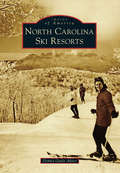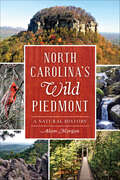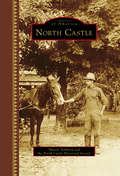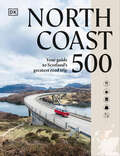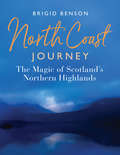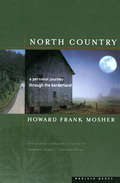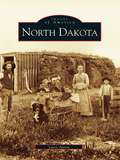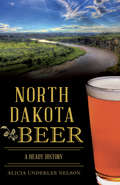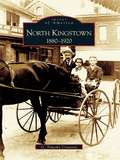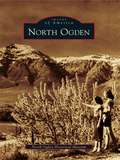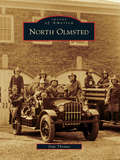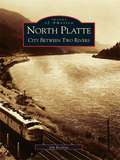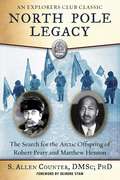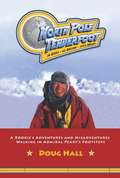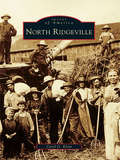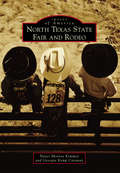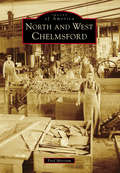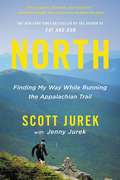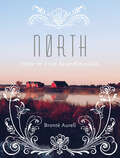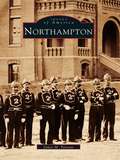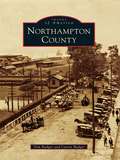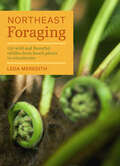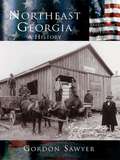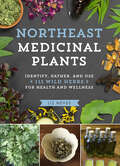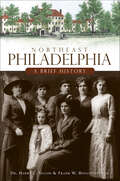- Table View
- List View
North Carolina Ski Resorts (Images of America)
by Donna Gayle AkersDuring the early 1960s, local leaders in western and northwestern North Carolina were dedicated to developing winter recreational opportunities in the mountains. North Carolina�s ski industry dates back to the winter of 1961�1962, when the Cataloochee resort in Maggie Valley developed the first ski slope in the state. Once thought impossible to make snow south of the Mason-Dixon Line, technological innovations in snowmaking allowed several other resorts to develop through the 1970s, including Appalachian Ski Mountain, Beech Mountain, Sugar Mountain, Wolf Ridge, and Ski Sapphire Valley, all of which still operate today. Images of smaller ski areas, such as Hound Ears, Seven Devils, and Mill Ridge, are featured to honor these now defunct clubs. Many of the present-day resorts have incorporated snowboarding, snowshoeing, ice-skating, and snow tubing, along with mountain biking trails for summer recreation on the slopes. North Carolina Ski Resorts showcases the rich recreational history of western and northwestern North Carolina.
North Carolina’s Wild Piedmont: A Natural History (Natural History)
by Adam MorganThe North Carolina Piedmont is rich in natural beauty and wildlife. Home to eleven state parks, three state natural areas, a national wildlife refuge and a national forest, the region offers more than just gently rolling hills. Tour the wild wine vines in Medoc Mountain State Park, marvel at the floodplains of the Haw River and follow the migratory birds in Pee Dee National Wildlife Refuge. Experience the natural history, field research, interviews with park rangers and firsthand experiences of the state's largest physiographic region. Author Adam Morgan joins in a rich tradition of nature writing to paint the majestic beauty and raw power of North Carolina's wild Piedmont.
North Castle (Images of America)
by North Castle Historical Society Sharon TombackThe town of North Castle in Westchester County is about 35 miles north of New York City and includes Armonk, Banksville and the Eastern District, and North White Plains. Home to half of the 2,145-acre Kensico Reservoir and Dam (primarily built by Italian stone masons using locally quarried stone), North Castle protects New York City's water supply, which inundates the lost Kensico Village. During the early 1920s, Route 22 became the "Gateway to the Berkshires," bringing prosperity to farm stands, restaurants, dance halls, bars, and hotels. During the late 1920s and through the 1930s, hundreds were treated to barnstorming, weekend rides, stunt flying, and parachuting at the Armonk airport. Lavish country estates at the turn of the 20th century became country clubs, housing subdivisions, and corporate parks by the beginning of the 21st century. Today, international corporations IBM and Swiss Re headquarter in town. More than 200 photographs in this book celebrate the remarkable people, places, and events that helped shape North Castle into the exceptional community it is today.
North Coast 500
by DK Travel Rachel LaidlerThe ultimate inspiration for this road trip of a lifetimeExplore the best of Scotland on the UK’s favourite road tripFairytale castles, white sand beaches, rugged mountains: there’s a reason why Scotland’s North Coast 500 is trending. Taking you along the edge of Scotland’s most dramatic coastline, this beloved route is a celebration of a spectacular corner of the country. And such a great road trip deserves a great book to match. Turn the pages of DK travel’s North Coast 500 to discover: Over 100 highlights to see along the route, from historic castles to beautiful beaches, local cafés to hidden hotspotsMaps detailing each leg of the routePractical information for your trip, including distances, durations and road conditions, as well as helpful what3words addresses to pinpoint every sightAuthor recommended places to eat, drink and stay along the wayIdeas for detours to explore even more of Scotland’s dramatic landscapes Ready to hit the road? Pop North Coast 500 in your glovebox and head for the horizon.
North Coast Journey: The Magic of Scotland's Northern Highlands
by Brigid BensonEnjoy the local color and majestic scenery of the Scottish Highlands with this essential road trip guide along the scenic North Coast 500. Known as Scotland&’s Route 66, the North Coast 500 takes travelers on a winding journey across northern Scotland&’s breathtaking coastline. Acclaimed Scottish travel writer Brigid Benson guides you on a journey that begins in the charming city of Inverness, then weaves westward to the historic village of Applecross and up the Atlantic coast to the most northerly points in Britain before heading back to Inverness along the North Sea. In addition to stunning mountains, moors, lochs and beaches, the route also features exquisite towns and villages, castles, distilleries and breweries. Benson divides the route into manageable daily itineraries, suggesting where to discover history, observe wildlife, meet great local characters, shop at quirky stores, taste outstanding food, drink in friendly bars and cafes, and stand in awe of amazing sights. She also recommends campsites, inns and other places to stay, along with places to picnic, swim, surf, walk and stargaze.&“For Scottish travel it doesn&’t get better than North Coast Journey, an eco-friendly, common sensical, well-researched foray around the locale of the North Coast 500 and beyond.&” —The Scotsman, UK
North Country: A Personal Journey Through the Borderland
by Howard Frank Mosher&“A richly observant memoir of a coast-to-coast journey along the US-Canada border . . . An armchair traveler&’s delight&” (Kirkus Reviews). &“Part travelogue, part memoir, part meditation, part exploration,&” North Country is an account of a trip along the northern border of the United States in search of the country&’s last unspoiled frontiers (The Boston Sunday Globe). In this vast, sparsely settled territory, Howard Frank Mosher found both a harsh and beautiful landscape and some of the continent&’s most independent men and women. Here, he brings this remote area to vivid life in a book &“bright with anecdote and history and lore and most importantly with affection for his human subjects&” (Richard Ford, Pulitzer Prize–winning author of Independence Day). &“A classic road book. You could, with confidence, place this book on the shelf next to such American classics as John Steinbeck&’s Travels with Charley and Jonathan Raban&’s Old Glory.&” —Detroit Free Press &“What Mosher&’s northern journey is really about is our society&’s loss of Eden, the garden we were promised when we came here. The garden we&’ve turned into pulp fiction and rocket ranges. The very fact that this brave book can stir up so many thoughts about the predicaments of civilization is surely an indication that it is well worth reading.&” —Ottawa Citizen
North Dakota
by Larry AasenDuring the early years of the 20th century, American families witnessed amazing changes in their daily lives--the arrival of plumbing and electricity in their homes, the first automobiles, and thanks to the Eastman Kodak Company, the first affordable, portable, photographic instrument, the box camera. Many families purchased the box camera (for $1) and began to document their own histories. It is upon these histories that North Dakota places its focus.Nowhere were the changes so dramatic as on the Great Plains, and in the state of North Dakota especially. Due to the huge influx of immigrants, mostly from Scandinavia, the state's population more than doubled from 1900 to 1940, roughly the period covered in North Dakota. But this was also a time ofhardship and struggle, as the Great Depression, theDustbowl, and war took their toll on North Dakotafamilies. But through hard work and perseverence, most of these families survived, and thrived, and nowshare with us the story of that time.
North Dakota Beer: A Heady History (American Palate)
by Alicia Underlee NelsonBefore North Dakota obtained statehood and entered the Union as a dry state, the region’s commercial beer industry thrived. A lengthy era of temperance forced locals to find clever ways to get a beer, such as crossing the Montana and Minnesota borders for a pint, smuggling beer over the rails and brewing at home. After Prohibition, the state’s farmers became national leaders in malting barley production, serving the biggest brewers in the world. However, local breweries struggled until 1995, when the first wave of brewpubs arrived on the scene. A craft brewing renaissance this century led to an explosion of more than a dozen craft breweries and brewpubs in less than a decade. Alicia Underlee Nelson recounts North Dakota’s journey from a dry state to a booming craft beer hub.
North Kingstown: 1880-1920
by G. Timothy CranstonIn the late 1880s, pharmacist Elwin "Doc" Young began to photograph the people, places, and events in his bustling crossroads community of North Kingstown. He turned the best of these images into postcards and sold them in hisapothecary shop. Today, readers can admire Young's impressive art in this volume, North Kingstown: 1880-1920. These pages highlight North Kingstown's golden era--a time when elite East Coast families on their way to Newportwould stop in quaint villages and mingle with the residents. These captivating images show the people, technology, and architecture of an important city at the beginning of the20th century.
North Ogden
by North Ogden Historical MuseumNorth Ogden is a quiet community nestled in the foothills of the Wasatch Mountains. The majestic Ben Lomond Peak silently towers over the city to the north with Lewis Peak standing guard to the east. Beautiful panoramic scenery is enjoyed in all directions. During the early 19th century, the city and surrounding areas were inhabited by the Spanish and Native Americans and explored by trappers. North Ogden City was established in 1851, and the challenges facing the pioneer families were numerous. Settlers encountered hostile Native Americans, hungry wild animals, devastating grasshopper invasions, and extreme weather conditions, and the food supplies were often depleted. Regardless, the city's population thrived, and farms, orchards, and businesses prospered. The perseverance of those early settlers is linked to the rich heritage treasured by the citizens of today.
North Olmsted (Images of America)
by Dale ThomasNorth Olmsted's history began in 1815 with David Johnson Stearns of Vermont. Stearns was followed to the area by other pioneers from New England, and they established a settlement in the wilderness of southwestern Cuyahoga County. North Olmsted went from being an isolated farming community to a village in 1908 and then to a city in 1951. The stage was then set for it to rapidly grow into a thriving suburb in the last half of the 20th century. North Olmsted's rich heritage is illustrated in this book through historic photographs from the Olmsted Historical Society that highlight the city's residents, businesses, social centers, and schools.
North Platte: City Between Two Rivers
by Jim BeckiusSituated at the junction of the North Platte and South Platte rivers, North Platte has a long history as an important stopping point in the westward migration of from the days of the California gold rush to the building of the transcontinental railroad and beyond. The Oregon Trail to the gold rush followed the South Platte River, and the Mormon Trail followed the North Platte River. In 1866 the building of the Union Pacific railroad stopped at North Platte for the winter. The railroad brought the town of North Platte to life. In 1869 the Union Pacific built a huge depot and hotel which stood until destroyed by fire in 1915. It entertained many famous visitors including William F. Cody, George Armstrong Custer, Bat Masterson, and Teddy Roosevelt. Since the 1920s North Platte has grown considerably, helped by the transcontinental Lincoln Highway which still runs through town. North Platte also had the first lighted runway in the United States, used for the air mail planes of the 1920s.
North Pole Legacy: The Search for the Arctic Offspring of Robert Peary and Matthew Henson
by S. Allen Counter Deirdre StamNorth Pole Legacy tells the story of two men whose existence was for decades nothing more than a popular legend. But that rumor was finally verified in 1986 when author S. Allen Counter journeyed to northern Greenland, and met this pair of remarkable men.Counter had long been an admirer of Matthew A. Henson, the African-American explorer who accompanied Admiral Robert E. Peary to the North Pole twice in early twentieth century. While conducting professional research in Sweden, Counter became intrigued by talk of mixed-race Inuit living in an isolated region of Greenland. Unable to forget this rumor, Counter traveled to investigate several years later, venturing more than a thousand miles north of the Arctic Circle. There, in two tiny villages, Counter met Anaukaq Henson and Kali Peary, Amer-Inuit sons of the two explorers. Born only days apart in 1906, they had long been acknowledged by their communities as the sons of Matthew Henson and Robert Peary, but had never been in contact with any of their American relatives. As it was obvious that these two men longed to see the country of their fathers, Counter arranged for Anakukaq, Kali, and their families to travel to America to meet their families.North Pole Legacy describes the obstacles that Counter overcame to bring news of Anaukaq Henson and Kali Peary to the world, to bring them to the United States, and to facilitate a reunion with relatives that they had never known. At the same time, the narrative flashes back to the unique history of Matthew Henson and Robert Peary in their collaboration as explorers and addresses their somewhat controversial claim to have been the first people to reach the North Pole.Compelling, insightful, and impossible to forget, North Pole Legacy is a must read for every history buff and armchair explorer.
North Pole Tenderfoot
by Doug HallWhy would Doug Hall follow in Robert Peary's 1909 sled tracks to the North Pole, despite the grueling terrain and temperatures between 15 and 62 degrees below zero? His goal was to resurrect the spirit of Peary's journey in a world increasingly driven by instant gratification, short term business focus, and lack of sustained dedication to great causes. Peary succeeded where some 578 expeditions before him had failed. North Pole Tenderfoot is Doug's attempt to let the reader experience what is possible when one does what Peary did: think big.
North Ridgeville (Images of America)
by Carol G. KlearNorth Ridgeville took root when 17 men, mostly members of the Beebe and Terrell families, left Waterbury, Connecticut, traveled west to Ohio, and established the first permanent settlement on May 10, 1810. Ridgeville Township was organized in 1813, centered at State Routes 20 and 83, and by the mid-1800s welcomed many people of German and English descent. In 1829, due to frequent mail mix-ups with Ridgeville, a town near Dayton, the postmaster general requested that the post office be named North Ridgeville. What was once a small farming community began to grow and prosper, and by 1958, North Ridgeville was incorporated as a village; two years later it became a city. Today the population nears 30,000, and North Ridgeville is flourishing, thanks to the hard work, determination, and pride of its forefathers.
North Texas State Fair and Rodeo (Images of America)
by Nanci Monroe Kimmey Georgia Kemp CarawayThe predecessor to the North Texas State Fair and Rodeo was reported in the October 15, 1885, Denton Doings as consisting of horse races sponsored by the Denton County Fair and Blooded Stock Association (DCFBSA). The next mention was 1890, when the association stockholders had the opportunity to purchase shares of the fairgrounds, thus ending the fair until five years later. The DCFBSA was reorganized in 1895 to host a fair and horse race near North Texas Normal College. The next race was held in 1896, and the association was incorporated. The fair has operated continuously since except for the years during World War II. These early events evolved into one of the largest fairs and rodeos in Texas, drawing more than 150,000 fairgoers annually.
North and West Chelmsford (Images of America)
by Fred MerriamThe Massachusetts town of Chelmsford, chartered in 1655, consisted of five villages. In the 1820s, industries related to the production of cast iron, textiles, and textile mill machinery made their first appearance in the North village along Stony Brook. Its social and economic life became aligned with the new industrial city of Lowell, and there had even been talk of secession from the Centre village in the mid-1800s. A golden age of industrial expansion and production occurred from 1875 to 1910. Industry in the West village consisted of blade and textile manufacturing in two locations, also tied to water power on Stony Brook, but this community was aligned socially and economically with nearby Nabnasset village in Westford. Discover the golden age of the North and West villages in photographs and learn about the people who made it happen.
North: Finding My Way While Running the Appalachian Trail
by Scott Jurek Jenny JurekFrom the author of the bestseller Eat and Run, a thrilling new memoir about his grueling, exhilarating, and immensely inspiring 46-day run to break the speed record for the Appalachian Trail.Scott Jurek is one of the world's best known and most beloved ultrarunners. Renowned for his remarkable endurance and speed, accomplished on a vegan diet, he's finished first in nearly all of ultrarunning's elite events over the course of his career. But after two decades of racing, training, speaking, and touring, Jurek felt an urgent need to discover something new about himself. He embarked on a wholly unique challenge, one that would force him to grow as a person and as an athlete: breaking the speed record for the Appalachian Trail. North is the story of the 2,189-mile journey that nearly shattered him.When he set out in the spring of 2015, Jurek anticipated punishing terrain, forbidding weather, and inevitable injuries. He would have to run nearly 50 miles a day, every day, for almost seven weeks. He knew he would be pushing himself to the limit, that comfort and rest would be in short supply -- but he couldn't have imagined the physical and emotional toll the trip would exact, nor the rewards it would offer.With his wife, Jenny, friends, and the kindness of strangers supporting him, Jurek ran, hiked, and stumbled his way north, one white blaze at a time. A stunning narrative of perseverance and personal transformation, North is a portrait of a man stripped bare on the most demanding and transcendent effort of his life. It will inspire runners and non-runners alike to keep striving for their personal best.
North: How to Live Scandinavian (How To Live... Ser.)
by Brontë AurellA complete guide to Scandinavia filled with travel tips, cultural and historical facts, recipes, and inspirational photography from the Nordic nations.Why are Scandinavians constantly topping the happiness table? How do you get more Scandi-style in your life? Just how do you use lagom? Whether you want your apartment to look like it belongs in Copenhagen, to workout like a Norwegian or to make cinnamon buns like a Swede, this is the ultimate insider’s guide to the countries of the north.Full of inspiration and ideas, how-tos and recipes to help you experience the very best of Scandinavian design, philosophy, cookery, and culture, this honest behind-the-scenes look at the culture provides an invaluable insight into the wonderful and visually stunning world of Scandinavia. Like her viking ancestors before her, Brontë Aurell left Denmark to explore the world beyond home shores and in her travels has come to understand the fascination with her kinfolk, as well as seeing the idiosyncrasies of the Scandinavian lifestyle that locals take for granted.With a signature wit and a keen eye for detail, she takes you on a journey through fjords and mountains, farmlands, and cities to better understand these three nations and what makes each one so unique. So get outdoors, learn the life lesson that there’s no such thing as bad weather (only bad clothing), and you may discover your inner Scandi sooner than you think . . . From the How To Live . . . series of insightful guides to some of the most intriguing cultures and locations on the planet, other books available include How To Live Japanese, How To Live Korean, and How to Live Icelandic.
Northampton
by James M. ParsonsThe beauty of the Connecticut River Valley in Massachusetts has always left visitors groping for superlatives, and the town of Northampton--once dubbed "The Athens of the Connecticut Valley"--has lately experienced a renaissance. Interest in the city has only risen through the years, and an assessment of its prominence throughout history easily explains its consistent attraction. From its settling in 1654 to the present, Northampton has been a hotbed of activity, idealism, growth, and change. Walking the streets of Northampton at different times were revolutionaries like Daniel Shays, patriots like Joseph Hawley, religious visionaries like Jonathan Edwards, idealists like the members of the utopian community in Florence, and governors like Caleb Strong and future president Calvin Coolidge. Notables like Sojourner Truth, Alexander Graham Bell, and President Franklin Pierce came and left, but their influences have remained.
Northampton County (Images of America)
by Curtis Badger Tom BadgerShortly after European colonists landed at Jamestown in 1607, they established a settlement in Northampton County. Settlers caught fish and shellfish in the shallow bays and creeks along the seaside and bayside and distilled salt from seawater to help preserve this bounty through the winter. Since 1608, Northampton has provided food for Virginia and the world. Fishing, crabbing, and clam aquaculture today are still an important part of the economic backbone of Northampton, but Northampton has been best known in recent years for land-based food production. The sandy soils of Northampton have always been productive, but when the railroad was built in 1884, it gave growers a method of getting produce to markets in a timely manner. So Northampton's history and culture have centered around food--gathering it, producing it, and shipping it--and the photographs in Images of America: Northampton County document this legacy.
Northeast Foraging: 120 Wild and Flavorful Edibles from Beach Plums to Wineberries (Regional Foraging Series)
by Leda Meredith“An invaluable guide for the feast in the East.” —Hank Shaw, author of the James Beard Award–winning website Hunter Angler Gardener Cook The Northeast offers a veritable feast for foragers, and with Leda Meredith as your trusted guide you will learn how to safely find and identify an abundance of delicious wild plants. The plant profiles in Northeast Foraging include clear, color photographs, identification tips, guidance on how to ethically harvest, and suggestions for eating and preserving. A handy seasonal planner details which plants are available during every season. Thorough, comprehensive, and safe, this is a must-have for foragers in New York, Connecticut, Massachusetts, Maine, New Hampshire, Vermont, Pennsylvania, New Jersey, Delaware, and Rhode Island.
Northeast Georgia: A History (Making of America)
by Gordon SawyerIn the late eighteenth century, waves of intrepid settlers made their way down the Great Wagon Road into the virgin wilderness of Northeast Georgia to find new homes and opportunity for land and wealth. Against a dramatic mountainous backdrop, these pioneers carved out farms and small communities in perilous isolation and created an American experience vastly different from that of the plantation-style society established along Georgia's coast. Battling Creek and Cherokee warriors, government intervention, natural disasters, and a landscape not easily tamed, year after year, these men and women of Northeast Georgia stamped their self-reliance, their perseverance, and their industriousness upon generations to follow and upon the very geography they called home.In Northeast Georgia: A History, readers travel across several centuries of change, from the early American Indian tribes that once made this territory their hunting grounds to the present day, a time of unprecedented growth and expansion in both industry and population. Truly a world unto itself, Northeast Georgia has served as a haven and destination for all classes over the past two centuries: the bold gold miners of 1829, the stalwart sustenance farmers, the social elite enjoying fresh mountain air at the many summer resorts, a multitude of businessmen seeking opportunity in railroading, cotton, lumber, and poultry farming, and bootleggers finding the landscape convenient for clandestine whiskey-making and distribution. These stories and more provide insight into understanding a people and place unique in Georgia.
Northeast Medicinal Plants: Identify, Harvest, and Use 111 Wild Herbs for Health and Wellness
by Liz NevesWildcraft your way to wellness! In Northeast Medicinal Plants, Liz Neves is your trusted guide to finding, identifying, harvesting, and using 111 of the region&’s most powerful wild plants. You&’ll learn how to safely and ethically forage, and how to use wild plants in herbal medicines including teas, tinctures, and salves. Plant profiles include clear, color photographs, identification tips, medicinal uses and herbal preparations, and harvesting suggestions. Lists of what to forage for each season makes the guide useful year-round. Thorough, comprehensive, and safe, this is a must-have for foragers, naturalists, and herbalists in Connecticut, Maine, Massachusetts, New Hampshire, New Jersey, New York, Pennsylvania, Rhode Island, and Vermont.
Northeast Philadelphia: A Brief History (Brief History)
by Frank W. Hollingsworth Dr. Harry SilcoxNortheast Philadelphia chronicles this area's history of transformation, from scattered communities to an urban center.Before the Consolidation Act of 1854 more than tripled the former capital's population, Northeast Philadelphia was a scattered group of pastoral communities just beyond the city limits. Holmesburg, Somerton and other small villages initially struggled but ultimately triumphed in their transition from rural townships to a bustling urban center. Dr. Harry C. Silcox has collaborated with Frank W. Hollingsworth to chart this fascinating evolution, from the demise of the family farm to neighbors uniting on the homefront during World War II. With such lively characters as Mary Disston, the founding mother of Tacony, and tales of the local effort for suffrage, Silcox and Hollingsworth create a brilliant and affectionate portrait of Northeast Philadelphia.
